Heart Failure Diagnosis and Treatment

OHSU offers compassionate, leading-edge heart failure care tailored to each patient’s needs.
We are known for:
- The largest and longest-running heart transplant program in the region, giving us unmatched expertise.
- A team-based approach that brings together heart specialists, surgeons, immunology experts and others from across OHSU.
- Advanced diagnostic tools to identify heart failure as soon as possible.
- Nurses, pharmacists, dietitians, physical therapists, social workers and others who support heart failure patients at all stages of treatment.
- Providers who are board-certified heart specialists, meaning they have additional training and deliver the highest standard of care.
- The latest technology and techniques, so we can bring our patients innovative care for heart failure.
Notice about the HeartWare HVAD Device
Medtronic has stopped making the HeartWare HVAD due to safety concerns. OHSU will no longer implant the HeartWare HVAD. We will still be implanting other LVAD devices, and we will still care for patients who already have the HeartWare HVAD.
Diagnosing heart failure
Learning if you have heart failure is the first step to taking control of your condition and planning for treatment.
There are many reasons for symptoms such as trouble breathing, chest pain, and swelling in your arms and legs. Your primary care doctor may notice these signs of heart failure. You also might be diagnosed in an urgent care clinic or the emergency room.
Your heart care team may use a combination of tests to confirm your diagnosis and collect information about how your heart works.
First steps
Diagnosis starts with a physical exam to look for signs that your heart is not pumping as it should. You may also have a chest X-ray to see if your symptoms are related to heart failure. The X-ray can show if your heart muscle is enlarged or if fluid is building up in your lungs.
We may also do blood tests to see whether your heart is supplying enough oxygen-rich blood to organs such as your kidneys, liver and brain.
Your doctor will often monitor your heart to see how it responds when asked to work harder. This is called a stress test. It can be done in a few ways. You may exercise on a stationary bike or treadmill. If it’s difficult for you to exercise, you may take medication to make your heart work harder.
In some cases, you may have a nuclear stress test. This test uses a small amount of radioactive dye and imaging technology to capture pictures of your heart when you exert yourself.
Imaging tests
Images can help us see exactly what is happening to weaken your heart. OHSU has world-class imaging specialists. We also invest in sophisticated cardiac imaging technology.
This includes:
Electrocardiogram (EKG or ECG): This test measures and records the heart’s electrical activity as a series of lines, waves and spikes. We use the results to understand the timing of your heartbeats and to find clues about structural changes to the heart muscle.
EKG: Electrocardiogram (ECG)
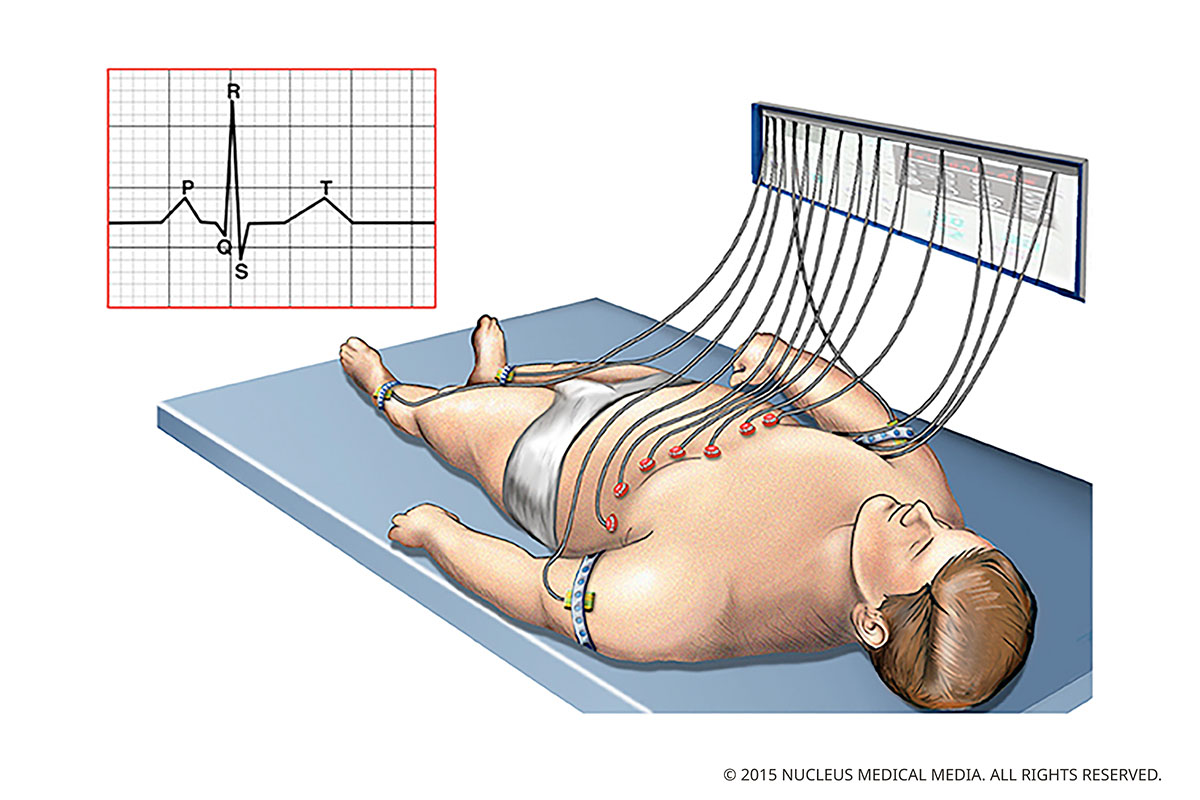
Echocardiogram (echo): An echocardiogram is an ultrasound of the heart. It uses sound waves to create moving images of the heart. It shows the heart’s structures and blood flow as the heart pumps. We use it to see how the ventricles and valves are working, and how thick the heart muscles are. Learn more.
Cardiac MRI (magnetic resonance imaging): This test uses radio waves and a strong magnet to show clear, detailed images of your moving heart. MRI allows us to measure blood flow and to see if the heart muscle is inflamed, scarred or stiff. Learn how it works.
Diagnostic heart (cardiac) catheterization: This test uses a long, thin, flexible tube called a catheter to reach your coronary arteries and identify any blockages. The experts in our state-of-the-art cardiac catheterization lab will insert the catheter into a vein or artery, usually in the groin, and guide it into place. A small amount of dye is then injected and tracked using X-ray imaging as the dye passes through the arteries.
PET (positron emission tomography) scan: This test uses a small amount of a radioactive substance called a tracer. It is added to your blood through an IV. The tracer can highlight areas where your heart may not be working as it should. We use it to check your heart’s blood flow and look for signs of damage to the heart muscle.
Heart failure treatment
At OHSU, treatment for heart failure is as varied as each patient. Our team will work with you to create a treatment plan that helps you be as healthy as possible at every stage of the disease.
When you come to an academic health center such as OHSU, you can expect to see world-class specialists for all aspects of heart failure. Often, you can see multiple experts in the same day.
Lifestyle changes
Your choices in diet, physical activity and managing stress can go a long way toward keeping heart failure from getting worse.
Together, lifestyle changes are called self-management. They put you at the center of managing your heart failure day to day. Self-management means listening to your body and contacting your care team if you notice changes.
Learn more on our Living with Heart Failure page.
Medication
Medication can help your heart muscle work better and help you feel better. Medications have many brand names but fall into categories, or “classes.”
You may benefit from several types of medication. We carefully develop a medication plan for each patient. We will consider all of your symptoms, your lifestyle and other conditions that affect your health.
Regular checkups are important to manage any side effects and to make sure you feel as well as possible.
Classes of heart failure medication
ACE inhibitors, ARBs and ARNIs: These medicines limit the effects of a hormone that narrows blood vessels. This in turn lowers blood pressure and reduces stress on the heart. These medications can improve heart failure symptoms, slow the disease and improve chances of survival. They are also called angiotensin converting enzyme inhibitors, angiotensin receptor blockers and angiotensin receptor neprilysin inhibitors.
Beta blockers: These medications are important for managing heart failure. Beta blockers limit the effects of adrenaline so your heart doesn’t work as hard. The heart beats slower and with less force, lowering blood pressure and possibly reducing chest pain. Beta blockers also improve blood flow and prevent irregular heart rhythms (arrhythmia).
Blood thinners: These medications, also called anticoagulants or antiplatelets, reduce the risk of blood clots. Blood thinners can lower the risk of heart attack, stroke or clots in the lungs (pulmonary embolism). Warfarin is a common anticoagulant. Aspirin is a common antiplatelet.
Calcium channel blockers: These medications block calcium from your heart and arteries, lowering blood pressure. Calcium channel blockers can treat heart failure caused by high blood pressure when other medications don’t work. They can also prevent angina (chest pain caused by limited blood flow to the heart).
Ivabradine (Corlanor): This medication treats chronic heart failure by slowing the heart rate. It can keep heart failure from getting worse, preventing hospitalization.
Digoxin: Also called digitalis, this medication improves heart muscle function and treats rhythm disorders such as atrial fibrillation. It works by controlling how much sodium and potassium reaches the heart. This reduces strain and helps maintain a strong heartbeat.
Diuretics: Also called “water pills,” diuretics help the body shed excess water and salt. This can reduce swelling, making it easier to breathe and easier for the heart to pump. Loop diuretics can lower levels of potassium, an electrolyte that helps the heart work. If you have severe heart failure, potassium-sparing diuretics may be a better option.
Hydralazine: This medication treats high blood pressure. A vasodilator, it works by widening blood vessels to improve blood flow and allow more oxygen-rich blood to reach the heart. Hydralazine may be combined with nitrates to take stress off the heart in people with congestive heart failure.
Nitrates: These blood pressure medications are vasodilators. Nitrates widen blood vessels, improving blood flow and reducing chest pain from angina. They can also relax veins so the heart doesn’t work as hard when blood returns from the arms and legs.
Statins: This type of medication lowers cholesterol in the blood. Statins prevent a waxy substance called plaque from building up in arteries. Plaque can limit blood flow to and from the heart. Statins can prevent heart attacks in people who are at high risk.

Devices to treat heart failure
A small electronic device can regulate your heart rhythm or monitor how your heart is working. Your heart care team will place the device and make sure you have regular checkups to make sure it’s working correctly.
Types of heart failure devices
Pacemaker: This battery-operated device is implanted under the skin, just below your collarbone. About the size of a silver dollar, a pacemaker helps the heart beat regularly. It sends electrical impulses if the heart beats too slowly and withholds these impulses if it beats normally or too fast.
Pacemaker Insertion
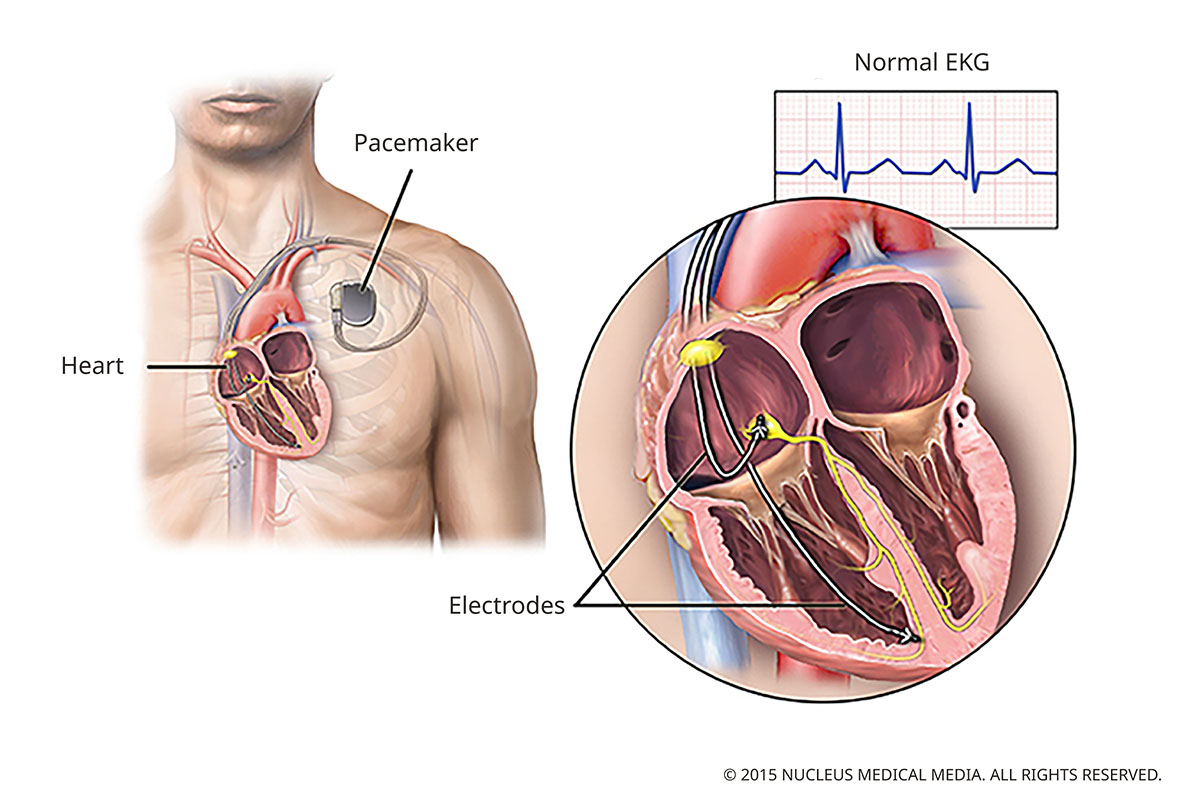
Cardio-MEMS: This monitoring device is placed in the blood vessel that moves blood from your heart to your lungs (pulmonary artery). It continuously measures your heart rate and lung filling pressures. It sends daily data to your care team. Cardio-MEMS is available only through heart specialty programs such as OHSU’s. It allows us to monitor you remotely, so you can stay at home and avoid being in the hospital.
Automatic implantable cardioverter defibrillator (AICD): This device, placed under the skin like a pacemaker, combines a pacemaker with a heart rhythm monitor. If your heart rate is elevated or abnormal, it can deliver an impulse to restore normal rhythm.
Implanted Cardioverter Defibrillator
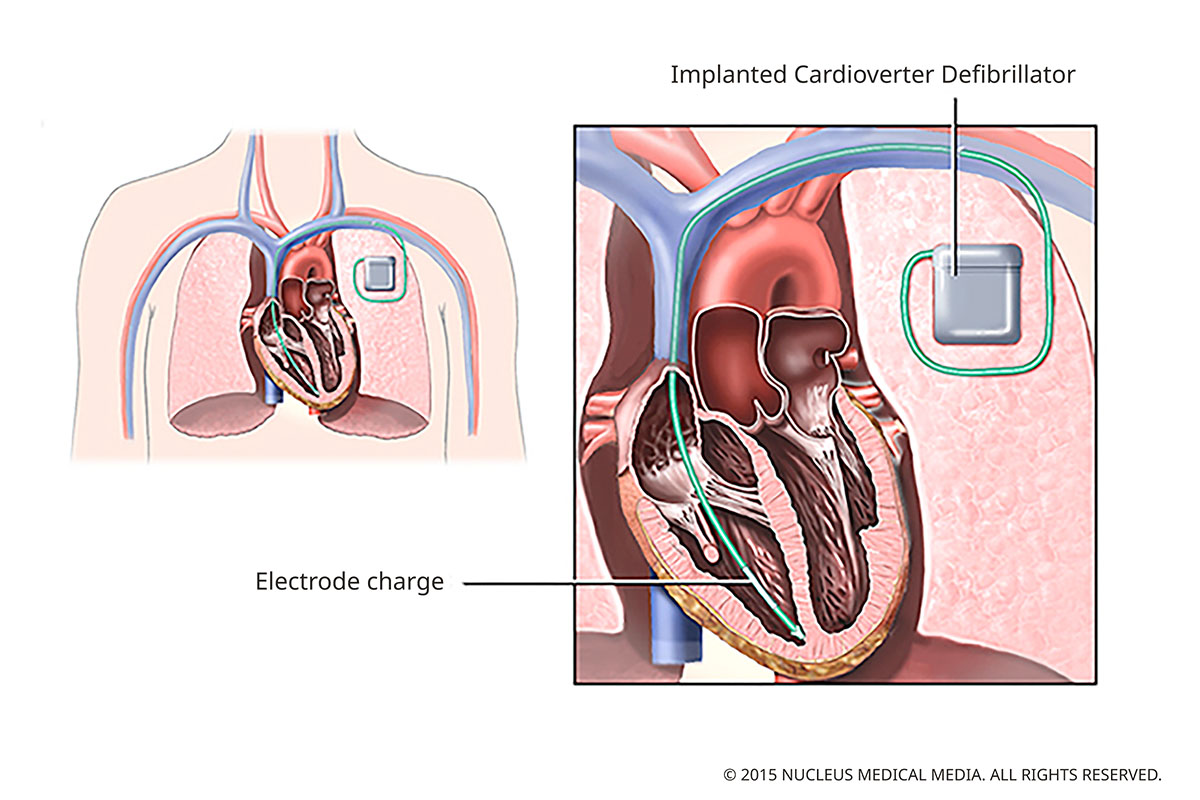
External vest defibrillator: This personal defibrillator is in a vest worn on the body. Your care team may suggest it as a temporary option while considering an AICD.
Mechanical circulatory support pumps
When the heart muscle gets weaker, your doctor may recommend placing a small pump in your chest. It takes over the pumping function of the heart, which can help you do more and live longer.
Our team has implanted more than 200 mechanical support devices, giving us the deep expertise that leads to better patient care.
Types of heart pumps
Intra-aortic balloon pump (IABP): This type improves blood flow when you are in the hospital. It controls flow through the main blood vessel, the aorta, and increases the heart’s ability to pump. A long, thin balloon rests in your aorta. It is connected to a computer through a flexible tube called a catheter. The computer inflates the balloon when your heart is relaxed and deflates it when your heart pumps.
Percutaneous heart pump: Also called a percutaneous ventricular assist device (PVAD), this type of heart pump is not implanted in the body. It connects to the circulatory system through tubes placed in an artery. It temporarily takes over pumping of the right or left side of the heart during a heart procedure or after a heart attack.
Ventricular assist device (VAD/LVAD): If you have severe heart failure and other treatments haven’t worked, a ventricular assist device may be an option. VADs help circulate blood in weakened hearts. They are implanted in your chest or abdomen and powered by batteries worn outside the body. VADs deliver blood from the heart’s lower chambers to the rest of the body. You may get a VAD while waiting for a heart transplant or as an alternative to a transplant.
Left Ventricular Assist Device
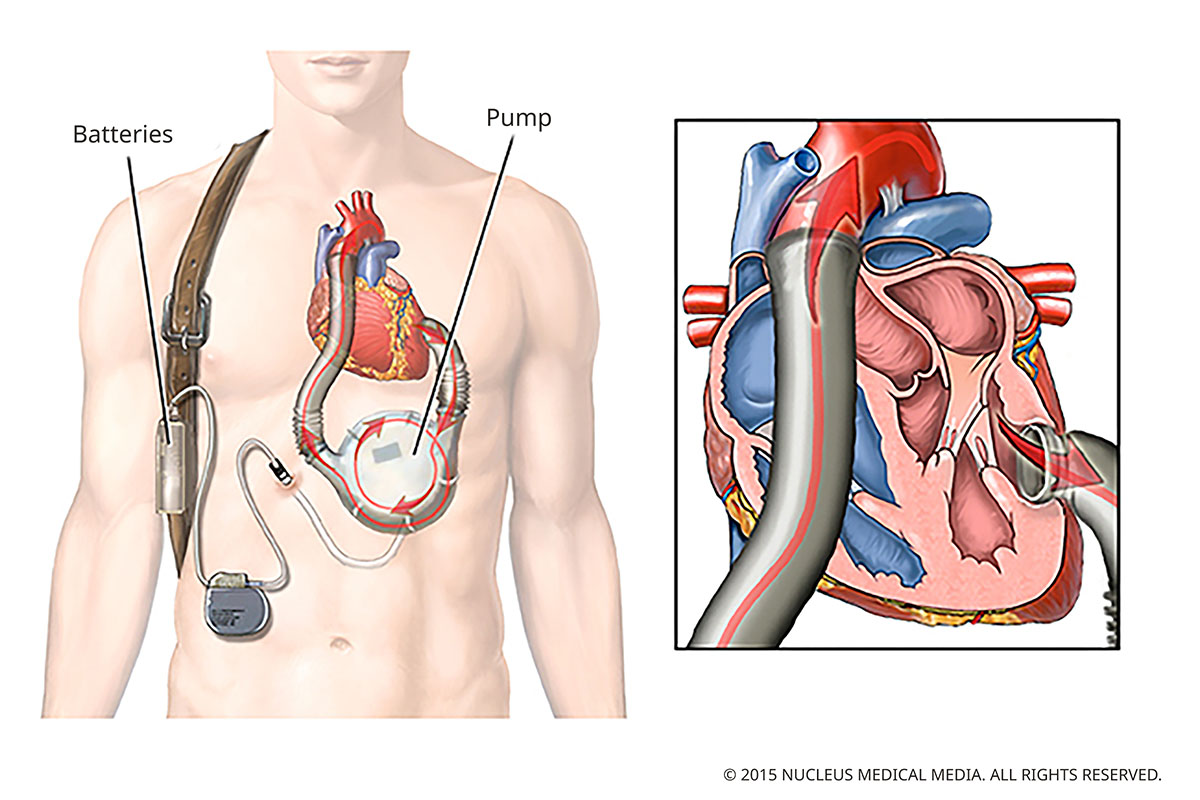
Heart rhythm, valve and blood vessel treatments
Issues with the way your heart beats, how valves open or close, or how blood moves through arteries can play a role in heart failure. Your care team may treat any or all of these issues to help you manage heart failure.
Heart rhythm treatment
Resynchronization therapy: A heart rhythm problem, such as atrial fibrillation (AFib), may keep your heart from filling up with blood to pump to the rest of your body. Resynchronization therapy uses a special kind of pacemaker to restore an irregular heartbeat. It sends impulses to the right and left sides of the heart to make sure they contract (squeeze) at the same time.
Our team works closely with experts in OHSU’s electrophysiology program to give you the best possible care for heart rhythm disorders. In some cases, you may be able to see a heart failure specialist and a heart rhythm specialist at the same time.
Blood vessel treatment
Your arteries (large blood vessels) can become blocked over time, reducing blood flow to your heart. Our team works with experts in surgery and minimally invasive procedures to improve heart function even in complex cases.
Procedures to clear a clogged coronary artery include:
Percutaneous coronary artery stenting (PCTA): A specialist will use a catheter to reach your coronary arteries and identify blockages. Blocked areas will be cleared with a small instrument that has a thin wire and special balloon. You may have a mesh tube (stent) inserted to hold the blood vessel open.
Stent Repair of Blocked Coronary Artery
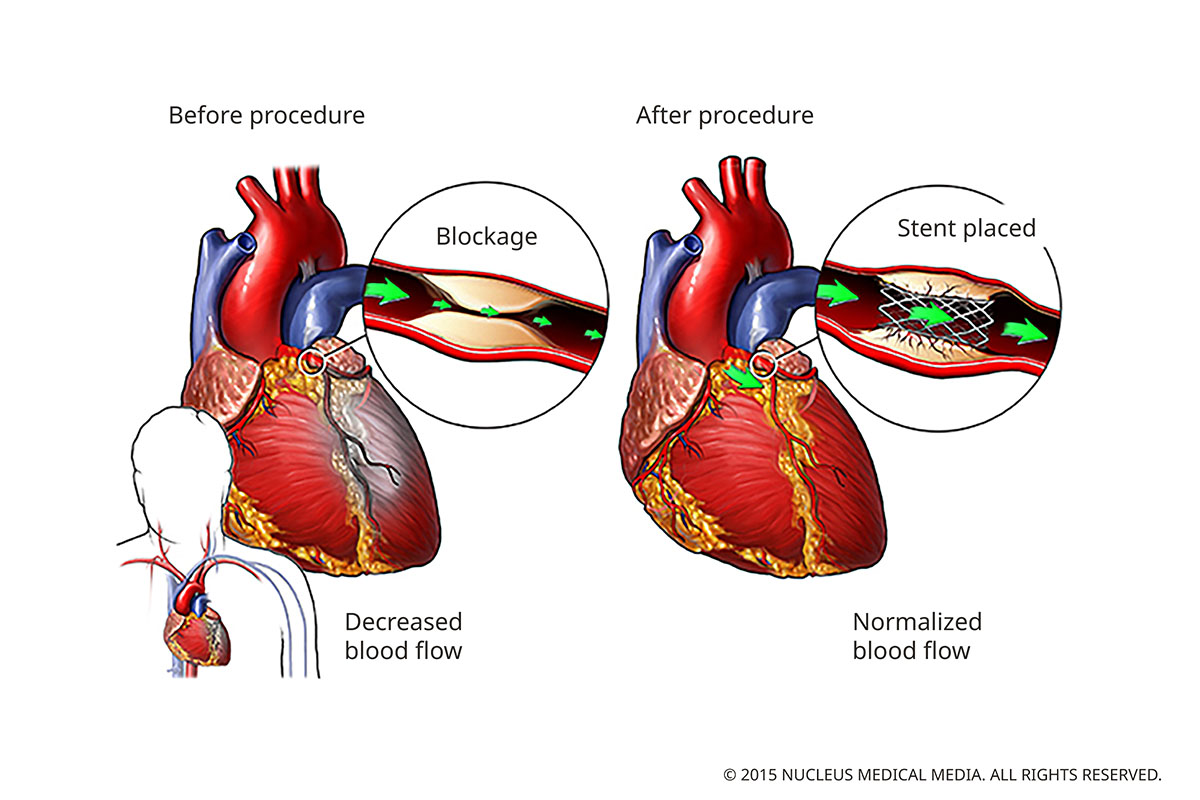
Coronary artery bypass grafting (CABG): A surgeon takes a blood vessel from another part of your body and attaches it to your coronary artery above and below the blockage, rerouting blood flow. Bypass grafts relieve symptoms of coronary artery disease. When combined with medication, CABG can slow heart failure.
Advanced valve treatment
Your heart has small openings called valves that open and close to control blood flow. When valves don’t work properly, it’s called heart valve disease. The main types are stenosis (narrowing of a valve) and regurgitation (a leaking valve.)
If you have heart valve disease, we’ll work with experts from OHSU’s nationally recognized heart valve program to tailor your treatment.
Valves that leak or need replacement can be treated with surgery or a less-invasive option using a catheter. OHSU’s valve experts are known for pioneering work in nonsurgical treatments.
Other treatments
No two people with heart failure have the same needs. Your care plan may include treatments to keep the disease in check or to manage your symptoms.
Heart care procedures: Your care team may recommend a minimally invasive procedure or surgery to treat a related heart problem. At OHSU, we have done these procedures for many years and have the latest equipment. This leads to better outcomes and faster recovery.
Dialysis or hemofiltration: Some people with heart failure also may have this treatment to help the kidneys remove fluids or toxins from the body. Reducing fluid buildup can help the heart work better.
Clinical trials: In some cases, you may benefit from a new treatment or approach being studied in a clinical trial. OHSU leads and takes part in dozens of these research projects, including to better understand and improve care. If a clinical trial may be right for you, your care team will discuss it with you.
Heart transplant
Heart transplants are major procedures to replace your heart muscle. A transplant will be considered only if other treatments haven’t helped enough.
Doctors at OHSU have been doing heart transplants since 1985. Our transplant surgeons, critical care specialists and advanced heart failure transplant cardiologists have completed more than 700 transplants. We offer deep expertise in these complex operations.
During a heart transplant, you’ll be connected to a heart-lung machine. It takes over the work of your heart so your heart can be still during surgery. Our transplant surgeons remove your ailing heart and replace it with a healthy donor heart.
At OHSU, you’ll also benefit from Oregon’s most extensive resources to help you prepare for a transplant and recover after surgery.
These include:
- Multi-organ failure services: You’ll have access to the expertise of OHSU’s other organ transplant teams, including liver and kidney.
- Immunogenetics and transplantation lab: Tissue compatibility testing makes sure a donor heart is a good match.
- Level 1 Trauma Center: OHSU has the highest level of round-the-clock care for treating complex heart problems, including heart failure.
- Cardiovascular intensive care: OHSU has a 24/7 unit devoted to caring only for the sickest heart patients.
- ECMO (extracorporeal membrane oxygenation): This is life support for people with potentially reversible heart failure or respiratory failure. OHSU is the only health system in the Pacific Northwest to offer air and ground transport for adult ECMO patients.
- Cardiac rehabilitation: A doctor-assisted exercise and education program can help patients rebuild stamina and recover after a heart transplant.
- Palliative care: An array of services to help you and your family manage anxiety, pain and symptoms from heart failure.
- Nutrition services: Our dietitians can help with heart-healthy eating plans tailored to your needs.
Learn more
- Heart Failure Screening, Diagnosis and Treatment, National Heart, Lung and Blood Institute
- Chronic Heart Failure Go-to Guide, Mended Hearts
- Treatment Options for Heart Failure, American Heart Association
- Heart Transplant, American Heart Association
- Heart Transplantation, U.S. National Library of Medicine
Location
Center for Health & Healing Building 1
3303 S. Bond Ave.
Portland, OR 97239
Refer a patient
- Refer your patient to OHSU.
- Call 503-494-4567 to seek provider-to-provider advice.
A heart pump turned his life around
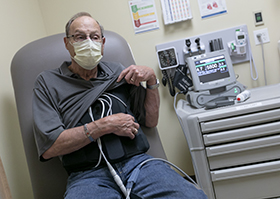
Thanks to his VAD, “I’m not tired all the time, I’m not huffing and puffing, I’m not retaining water,” Dennis Surmon says. Read his heart failure story.